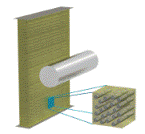Mechanical and Materials Engineering, Department of

Department of Engineering Mechanics: Dissertations, Theses, and Student Research
Characterization of Interlayer Laser Shock Peening during Fused Filament Fabrication of Polylactic Acid (PLA)
Copyright 2023, Fabien Denise
Abstract
The field of additive manufacturing (AM) has gained a significant amount of popularity due to the increasing need for more sustainable manufacturing techniques and the adaptive development of complex product geometries. The problem is that AM parts routinely exhibit flaws or weaknesses that affect functionality or performance. Over the years, surface treatments have been developed to compensate certain flaws or weaknesses in manufactured products. Combining surface treatments with the modularity of additive manufacturing could lead to more adaptable and creative improvements of product functions in the future. The current work evaluates the feasibility of pursuing a new research axis in the field of additive manufacturing for mechanical and chemical treatments during the making of polymers. The interest here is to investigate the effects of combining laser shock peening (LSP) in a multilayer AM product by introducing interlayer surface treatments that cold work the temporarily exposed layer. Shot peening has already proven effective at increasing mechanical strength of polymer materials in interlayer peening processes by locally inducing compressive residual stresses (CRSs). However, only few publications concern LSP on polymers, this could be due to the high-energy output of lasers that seems incompatible with the low tensile strength of polymers. In addition to evaluating this assumption, this project has the goal of exploring the effects of peening on different layers. Traditionally, each peened layer is separated by a fix number of unpeened layers, commonly referred to as fixed interval hybrid AM. However, ideal solutions for peening layer intervals are hypothesized to be irregular. Here, the aim was to study more diverse distribution patterns by comparing periodic and irregular intervals. Since the understanding of the effects of LSP on polymers is very limited, different aspects of thermo-mechanical behavior were evaluated.
Advisor: Michael P. Sealy

